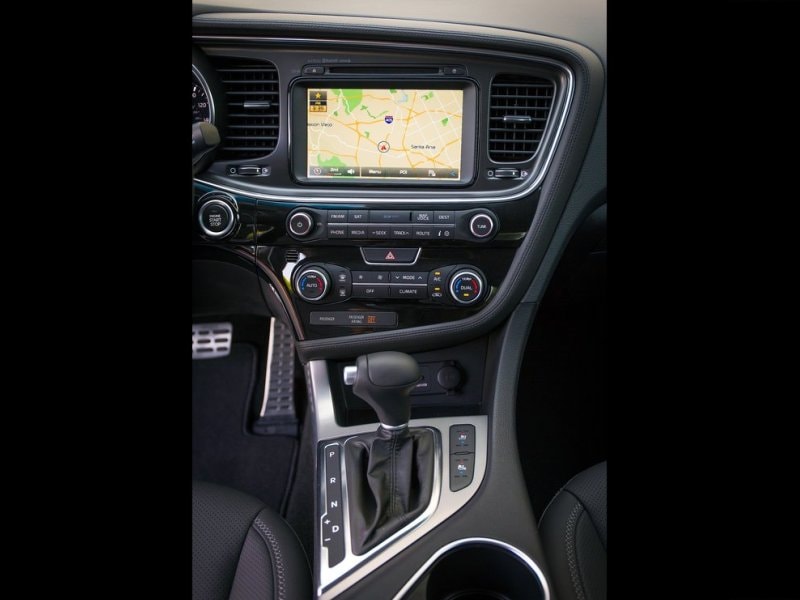Recent Articles
Popular Makes
Body Types
2015 Kia Optima Road Test & Review
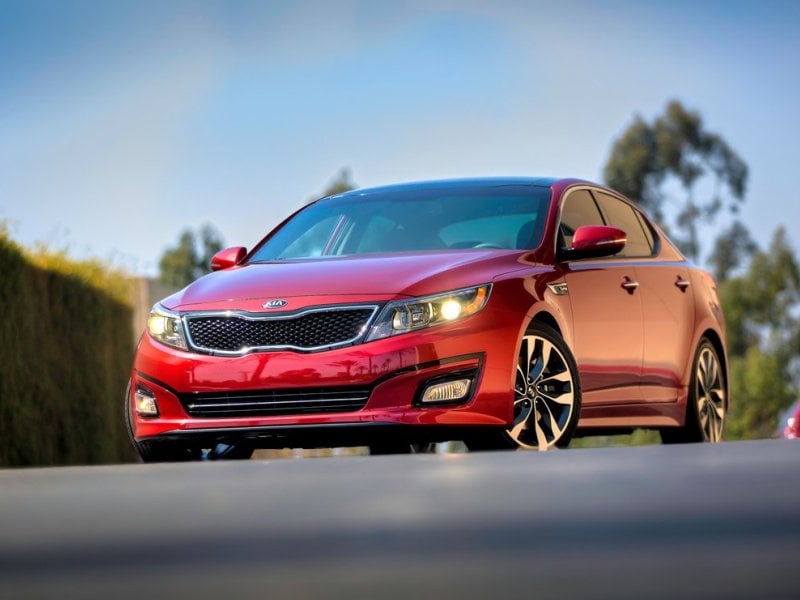
The hottest segment of the automotive marketplace is the family sedan category. This is where the industry heavyweights — Toyota’s Camry and Honda’s Accord — have held down the top spots for-pretty-much-ever. When you’re fielding a car in this category, you have to come real correct if you want to have a shadow of a prayer at being competitive.
In the case of the Optima, Kia has endowed the model with crisp styling and an exceptional array of standard comfort and convenience features — along with an exceptional warranty — in a bid to gain some attention in a class in which the two dominant players each routinely chalk up sales in excess of 350,000 units every year.
For comparison’s sake, consider this; the entire BMW group sold 395,850 cars in the US in 2014, that number includes Mini, Rolls-Royce, and every BMW model. Toyota and Honda each sell almost as many Camrys and Accords as BMW sells cars—period.
It’s a large and lucrative market, and Kia is hoping enough people will feel the Optima has the goods to carve out a generous number of buyers. So, of course, this invites the question; does the Optima have what it takes?
Models & Pricing
For the 2015 model year, Kia is offering the standard LX-trimmed Optima at a base price of $21,650. Other trim levels include the $24,100 EX, the $25,700 SX, the $27,700 SX Turbo, and the $35,500 Limited.
Optima LX standard features include 16-inch alloy wheels, projector beam headlights, LED turn signal repeaters in the exterior rearview mirror housings, variable intermittent windshield wipers, a heated rear window, automatic headlights, fog lights, Bluetooth, cruise control, full power accessories, remote keyless entry, a cooling glove box, a power adjustable driver’s seat, and a 60/40 split folding rear seat.
Moving up to Optima EX adds 17-inch alloy wheels, dual-zone automatic climate control, glovebox illumination, carpeted floormats, leather seat trim, wood decal appliqué accents, satin chrome interior trim, plus a leather and wood-grain shift knob.
The sporty Optima SX includes aerodynamic styling elements, machined finished 18-inch alloy wheels, and steering wheel mounted paddle shifters for the transmission.
SX Turbo gets all of the SX model’s features, plus a more powerful turbocharged engine.
Optima Limited adds chromed 18-inch alloy wheels and exterior trim accents, along with HID swiveling headlights, plus LED foglights, positioning lights, and rear combination lamps. Interior features include an Infinity surround audio system, KIA’s UVO eServices Infotainment system, voice command navigation, a rear-view camera, a rear parking sensor array, blind spot monitoring, rear cross traffic alert, a sport steering wheel, TFT LCD instrumentation, an electronic parking brake with auto hold, an auto-dimming interior rearview mirror, and Nappa leather trim.
It’s also worth noting many of the features of the Limited trim package are available as options for the rest of the Optima lineup.
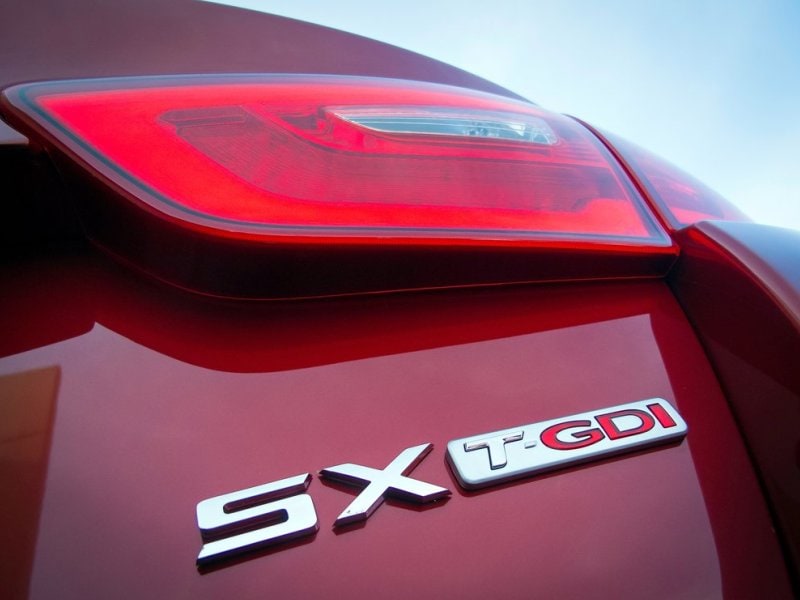
Design
If you see more than a hint of Audi in the crisply extruded lines of the Optima, it’s because Kia’s head of design — Peter Schreyer — spent a number of years formulating the styling language of the premium German brand. As a result, Kia’s models are now gifted with looks far exceeding what is typically expected of their price range.
In other words, Optima looks way more expensive than it actually is.
Another testament to the beauty of the design of the Kia is the fact it has been on the market since 2010, effectively making it the oldest design in the category. All of the Kia’s competitors have seen refreshed styling since then. That the car still looks contemporary and continues to stand up so well to the other cars in its competitive set is a true testament to the talents of Mr. Schreyer.
All in all, the 2015 Kia Optima is one very tasteful looking automobile.
The Kia’s classic long nose/short rear deck proportions are enhanced by a gentle wedge-shaped profile with a fast windscreen and an artfully drawn C pillar. The Optima’s wheelwells are subtly flared, and frame the handsome wheel designs offered with the Kia mid-size sedan quite nicely. A judicious sprinkling of chrome accenting brightens the look of the car, without imposing ostentation. Combined, the elements lend the Optima a look of substance.

Features & Controls
Patterned after some of the industry’s best performance models, the Optima’s control layout imparts instant familiarity.
The driver-focused cockpit is logically arranged and speaks specifically to the fact the interior of the Optima is focused around its driver. The nicely sculpted steering wheel frames a purposeful-looking instrument panel with two main dials and a center information window for secondary information.
Depending upon how the car is equipped, the steering wheel contains control for a variety of functions; including cruise control, the audio system, communications, and trip computer information. The sporty SX models also feature paddles for shifting the transmission behind the steering wheel.
Handsomely bookended by a pair of HVAC outlets is the full-color touchscreen monitor for Optima’s navigation, climate, and audio systems. The controls for these features are a logically arrayed combination of dials and pushbuttons, all legibly labeled and situated just beneath the monitor. Also housed within this system is Kia’s optional electronics interface referred to as UVO (you-voh). UVO provides voice-controlled telephony, entertainment functions, and navigation input.
One look at the shift lever tells you it was sculpted specifically to feel good in the hand, and grasping it confirms the eye’s impression. Just ahead of the shift lever on the center console is the switch for the electric parking brake (on models so equipped).
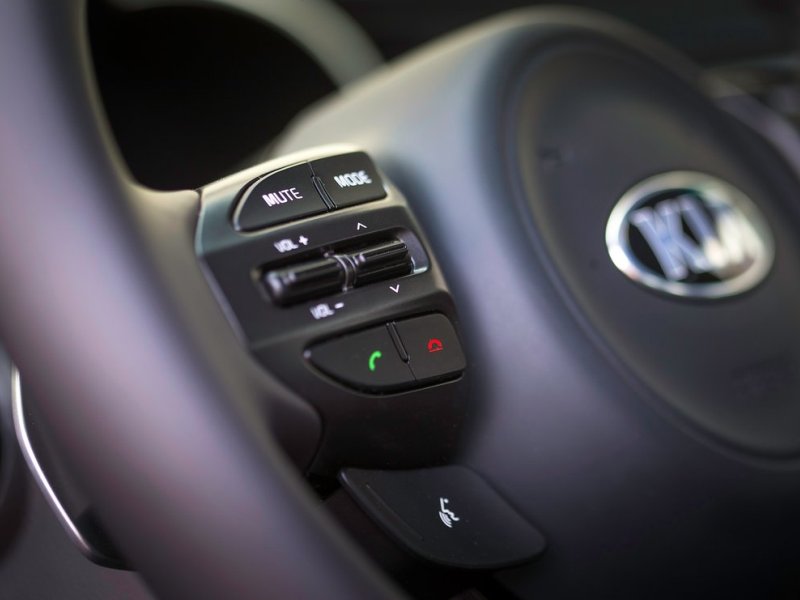
Comfort & Cargo
The reasonably spacious cabin is finished with soft-touch materials pretty much everywhere some part of your body would come into contact with the interior of the car. Legroom, both front and rear, is good for four adults, and headroom is adequate in the back seat, even with the graceful rearward taper of the roof. The optional panoramic sunroof can potentially compromise headroom though, so folks on the taller side might want to make sure they experience the car with the roof installed before they commit to buying one so equipped.
Ingress and egress are readily accomplished; the doors open wide and there are no impediments to easy entry or exit. Once seated in the rear, in addition to reasonable legroom, occupants will find good knee-room as well, thanks to the sleek design of the front seats. The Optima also offers air conditioning outlets and a power port in the center console for its rear seat occupants.
The Kia’s trunk is about average for the mid-size sedan segment, offering 15.4 cubic feet of cargo capacity. This can be expanded somewhat, as the rear seatback folds in a 60/40 split to provide additional room for longer items.
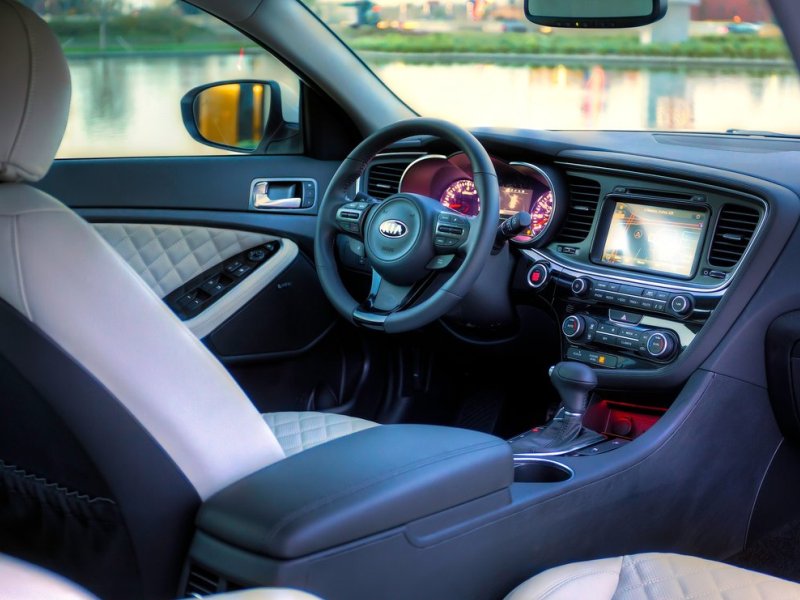
Safety Equipment & Crash Ratings
The Optima’s standard suite of safety gear includes ABS with disc brakes at all four wheels, traction control, stability control, and a full complement of airbags. If you get an Optima outfitted with the upgraded UVO system you’ll also acquire collision notification, the capability of summoning roadside assistance, and you’ll be able to set restrictions for teen drivers—or anyone you may happen to loan the car to.
As we noted in the Models and Pricing section of this posting, the Optima offers a host of cutting edge optional electronic safety features. These include a rear-view camera, a rear parking sensor array, blind spot monitoring, and rear cross traffic alert.
NHTSA found the Optima worthy of a five-star rating for overall crash performance, including both total frontal impact and side impact. The Insurance Institute of Highway Safety says Optima rates its top ranking (Good) in moderate overlap frontal offset, side impact, roof strength, and whiplash protection.
The IIHS small overlap frontal offset crash test resulted in a second best (Acceptable) ranking for the mid-size Kia.
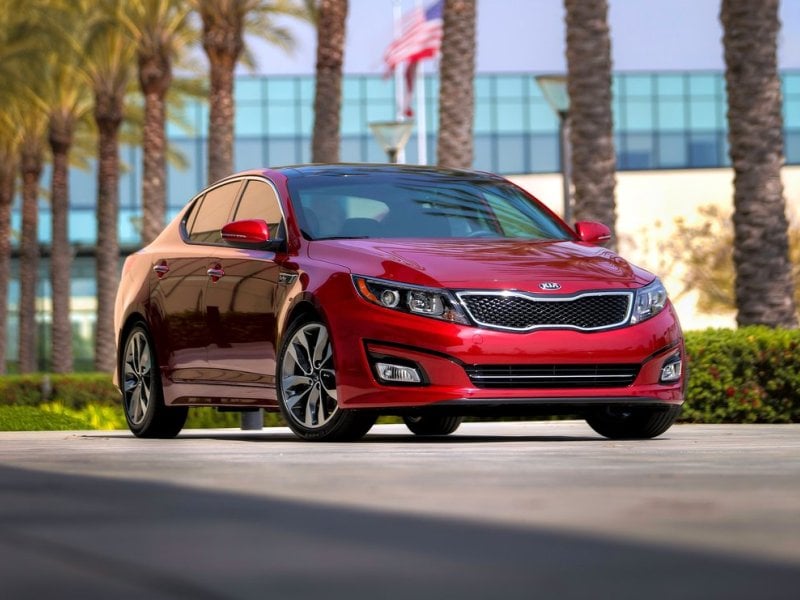
Engines & Fuel Economy
The base engine, featured in all trim levels save SX Turbo and EX, is a 2.4-liter inline four-cylinder, good for 192 horsepower and 181 ft-lbs of torque. Mated to the Kia’s six-speed automatic transmission, the engine feeds the front wheels and returns 23 miles per gallon in the city, 34 mpg on the highway, and 27 combined.
Kia Optima SX Turbo and Optima Limited get a 2.0-liter turbocharged four good for 274 horsepower and 269 ft-lbs of torque. Front-wheel drive and the six-speed automatic are teamed with this engine as well. Fuel economy is rated at 20 miles per gallon in the city, 31 mpg on the highway, and 24 combined.
Kia’s Drive Mode Select system is fitted to the more sporting-oriented Optima SX Turbo and Limited models, providing adjustable transmission shift points and steering weight to accommodate the more aggressive driving anticipated with the more powerful engine. The six-speed automatic transmission’s Sportmatic function allows it to offer manual gear selection regardless of engine choice.
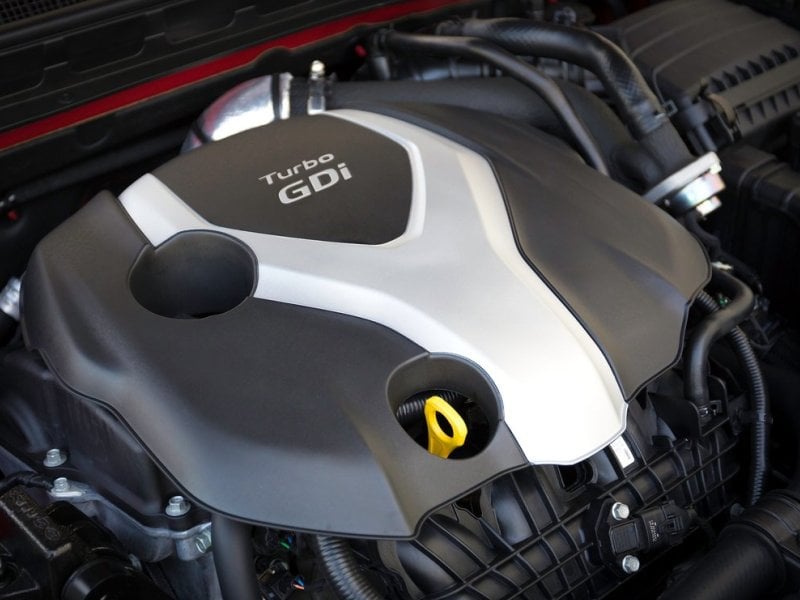
Driving Impressions
The Optima goes down the road in a rather comfortable fashion, without subjecting its occupants to a great deal of road and wind noise. For many years, it was readily apparent to sensitive drivers how Kia (and its sister company Hyundai) could offer so much content in its cars at prices so considerably less than the rest of the models in their competitive sets. All you had to do was listen. The Korean cars were considerably noisier than their competition.
In the case of the Optima, those days are gone. In fact, Kia even offers an acoustic laminated windshield across the entire Optima model range for the 2015 model year. Previously, this was only fitted to the top of the line Optima models. This newfound quiet adds considerably to the premium feel the Kia imparts.
Of course, you can only do so much at this price point; so even though the Kia looks like an Audi, and is largely outfitted like an Audi, don’t expect it to function with the German car’s characteristic fluidity and suppleness. Now, this is not to say Optima's a rough-riding piece of crap; in fact, quite the opposite is true.
The Kia is acceptably smooth, quiet and comfortable. It just isn’t as smooth, quiet and comfortable as an Audi. And, given the price of the Kia, it isn’t really fair to expect it to be. On the other hand, the Accord and the Camry do best the Kia in these categories, so there’s something to consider in this regard.
Taken on its own, the overall driving experience is quite competent. While the turbo engine won’t exactly set your hair on fire, its performance is enough better than the normally aspirated engine’s to justify its additional cost, particularly when you take the additional equipment offered with it into consideration.
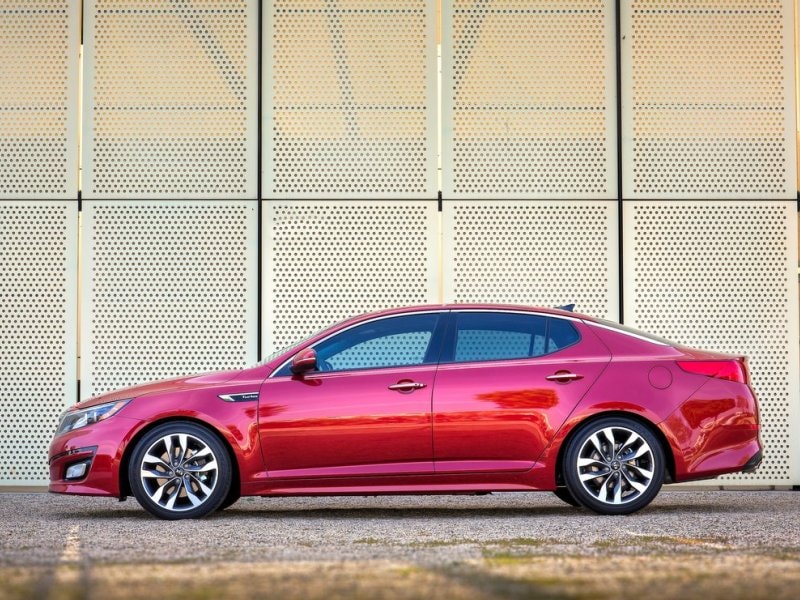
Final Thoughts
Despite its looks, you won’t go chasing down BMWs in a Kia Optima. Yes, the car has sporty overtones, and while we won’t exactly characterize the Optima as being more show than go, we will say it isn’t really a performance car.
Where the Kia differentiates itself from the other mid-size sedans on offer is in its ability to offer a sporty appearance with decent performance; while also delivering an outsized list of standard comfort and convenience features for the price. The Kia’s warranty kicks asterisks too; 10 years or 100,000 miles on the powertrain, five years or 60,000 miles bumper to bumper, plus five years or 60,000 miles of free roadside assistance.
With that said, as we mentioned at the beginning of this review, the Optima is playing in a category bristling with standouts. In addition to Camry and Accord, these include Ford’s Fusion, Mazda’s Mazda6, and Nissan’s Altima; each of which offer more engaging driving characteristics than the Optima—as well as recent redesigns. Long story short, while the Kia Optima has a lot going for it — and you certainly won’t go wrong choosing to make one your own — there are some other compelling choices out there.
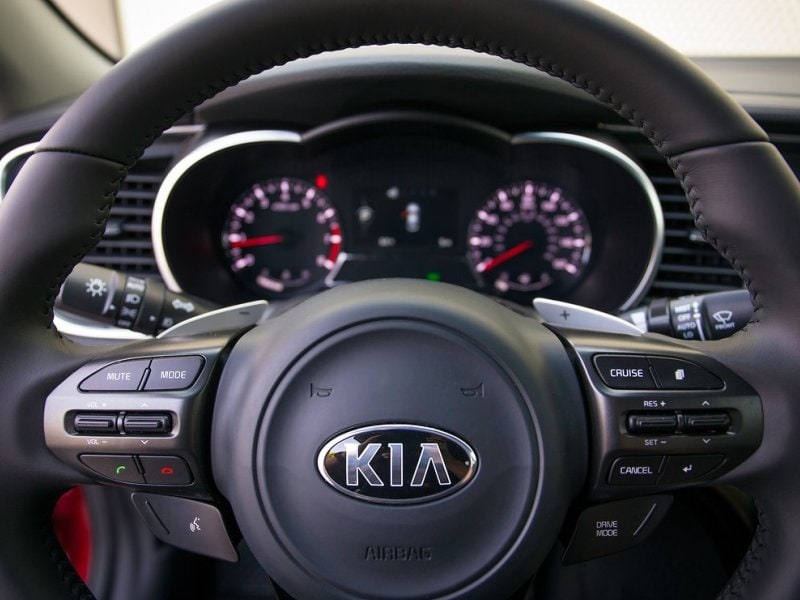
Pros & Cons
Pros: Long list of standard features, classy styling, good crash scores, killer warranty
Cons: Optima’s age is catching up to it
